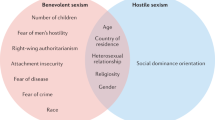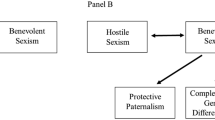Abstract
The special issue on Ambivalent Sexism (Glick and Fiske 1996, 1999, 2001) reflects the current landscape of ambivalent sexism research. This introduction reviews the theory, exploring the particularly insidious case of benevolent sexism. Next, it presents the included papers, which range broadly, but generally fit one of three research streams in the development of ambivalent sexism research. Some papers focus on converging correlations, exploring ambivalent sexism’s relation to other ideologies and cultural dimensions. Other papers demonstrate causality in context, revealing impact on targets and the prescriptive power of ambivalent ideologies. A third line documents converse causality, illustrating impact on perceivers’ self processes. Finally, we discuss possible future areas of research.
Similar content being viewed by others
References
Abrams, D., Viki, G. T., Masser, B., & Bohner, G. (2003). Perceptions of stranger and acquaintance rape: The role of benevolent and hostile sexism in victim blame and rape proclivity. Journal of Personality and Social Psychology, 84, 111–125.
Barreto, M., & Ellemers, N. (2005). The burden of benevolent sexism: How it contributes to the maintenance of gender inequalities. European Journal of Social Psychology, 35, 633–642.
Barreto, M., Ellemers, N., Piebinga, L., & Moya, M. (2010). How nice of us and how dumb of me: The effect of exposure to benevolent sexism on women’s task and relational self-descriptions. Sex Roles, this issue.
Becker, J. C. (2010). Why do women endorse hostile and benevolent sexism? The role of salient female subtypes and internalization of sexist contents. Sex Roles, this issue.
Berdahl, J. L. (2007). The sexual harassment of uppity women. Journal of Applied Psychology, 92, 425–437.
Berdahl, J. L., Magley, V. J., & Waldo, C. R. (1996). The sexual harassment of men: Exploring the concept with the theory and data. Psychology of Women Quarterly, 20, 527–547.
Berkowitz, A. D. (2003). Applications of social norms theory to other health and social justice issues. In H. W. Perkins (Ed.), The social norms approach to preventing school and college age substance abuse: A handbook for educators, counselors, and clinicians (pp. 259–279). San Francisco: Jossey-Bass.
Bohner, G., Ahlborn, K., & Steiner, R. (2010). How sexy are sexist men? Women’s perception of male response profiles in the ambivalent sexism inventory. Sex Roles, this issue.
Bosson, J. K., Pinel, E. C., & Vandello, J. A. (2010). The emotional impact of ambivalent sexism: Forecasts versus real experiences. Sex Roles, this issue.
Burn, S. M., & Busso, J. (2005). Ambivalent sexism, scriptural literalism, and religiosity. Psychology of Women Quarterly, 29, 412–418.
Christopher, A. N., & Mull, M. S. (2006). Conservative ideology and ambivalent sexism. Psychology of Women Quarterly, 30, 223–230.
Cikara, M., Eberhardt, J. L., & Fiske, S. T. (under review). From agents to objects: Sexist attitudes and neural responses to sexualized targets.
Dardenne, B., Dumont, M., & Bollier, T. (2007). Insidious dangers of benevolent sexism: Consequences for women’s performance. Journal of Personality and Social Psychology, 93, 764–779.
Dumont, M., Sarlet, M., & Dardenne, B. (2010). Be too kind to a woman, she’ll feel incompetent: Benevolent sexism shifts self-construal and autobiographical memories toward incompetence. Sex Roles, this issue.
Durán, M., Moya, M., Megías, J. L., & Viki, T. G. (2010). Social perception of rape victims in dating and married relationships: The role of perpetrator’s benevolent sexism. Sex Roles, this issue.
Eastwick, P. W., Eagly, A. H., Glick, P., Johannesen-Schmidt, M., Fiske, S. T., Blum, A., et al. (2006). Is traditional gender ideology associated with sex-typed mate preferences? A test in nine nations. Sex Roles, 54, 603–614.
Erikson, W., & Einarsen, S. (2004). Gender minority as a risk factor of exposure to bullying at work: The case of male assistant nurses. European Journal of Work and Organizational Psychology, 13, 473–492.
Feather, N. T. (2004). Value correlates of ambivalent attitudes toward gender relations. Personality and Social Psychology Bulletin, 30, 3–12.
Fields, A. M., Swan, S., & Kloos, B. (2010). ‘What it means to be a woman’: Ambivalent sexism in female college students’ experiences and attitudes. Sex Roles, this issue.
Fischer, A. R. (2006). Women’s benevolent sexism as reaction to hostility. Psychology of Women’s Quarterly, 30, 410–416.
Fiske, S. T. (2010). Social beings: Core motives in social psychology (2nd ed.). New York: Wiley.
Forbes, G. B., Adams-Curtis, L. E., Hamm, N. R., & White, K. B. (2003). Perceptions of the woman who breastfeeds: The role of erotophobia, sexism, and attitudinal variables. Sex Roles, 49, 379–388.
Fowers, A. F., & Fowers, B. J. (2010). Social dominance and sexual self-schema as moderators of sexist reactions to female subtypes. Sex Roles, this issue.
Glick, P., & Fiske, S. T. (1996). The ambivalent sexism inventory: Differentiating hostile and benevolent sexism. Journal of Personality and Social Psychology, 70, 491–512.
Glick, P., & Fiske, S. T. (1997). Hostile and benevolent sexism: Measuring ambivalent sexist attitudes toward women. Psychology of Women Quarterly, 21, 119–135.
Glick, P., & Fiske, S. T. (1999). The ambivalence toward men inventory: Differentiating hostile and benevolent beliefs about men. Psychology of Women Quarterly, 23, 519–536.
Glick, P., & Fiske, S. T. (2001). Ambivalent sexism. In M. P. Zanna (Ed.), Advances in experimental social psychology, vol. 33 (pp. 115–188). Thousand Oaks: Academic.
Glick, P., Diebold, J., Bailey-Werner, B., & Zhu, L. (1997). The two faces of Adam: Ambivalent sexism and polarized attitudes toward women. Personality and Social Psychology Bulletin, 23, 1323–1334.
Glick, P., Fiske, S. T., Mladinic, A., Saiz, J. L., Abrams, D., Masser, B., et al. (2000). Beyond prejudice as simple antipathy: Hostile and benevolent sexism across cultures. Journal of Personality and Social Psychology, 79, 763–775.
Glick, P., Lameiras, M., Fiske, S. T., Eckes, T., Masser, B., Volpato, C., et al. (2004). Bad but bold: Ambivalent attitudes toward men predict gender inequality in 16 nations. Journal of Personality and Social Psychology, 86, 713–728.
Good, J. J., & Rudman, L. A. (2010). When female applicants meet sexist interviewers: The costs of being a target of benevolent sexism. Sex Roles, this issue.
Guttentag, M., & Secord, P. (1983). Too many women? Beverly Hills: Jossey-Bass.
Jackman, M. R. (1994). The velvet glove: Paternalism and conflict in gender, class, and race relations. Berkeley: University of California Press.
Jost, J. T., & Banaji, M. R. (1994). The role of stereotyping in system-justification and the production of false-consciousness. British Journal of Social Psychology, 33, 1–27.
Kilianski, S. E., & Rudman, L. A. (1998). Wanting it both ways: Do women approve of benevolent sexism? Sex Roles, 39, 333–352.
Kilmartin, C., Smith, T., Green, A., Heinzen, H., Kuchler, M., & Kolar, D. (2008). A real time social norms intervention to reduce male sexism. Sex Roles, 59, 264–273.
Lee, T. L., Fiske, S. T., & Glick, P. (2010). Ambivalent sexism in close relationships: (Hostile) power and (benevolent) romance shape relationship ideals. Sex Roles, this issue.
Masser, B., Lee, K., & McKimmie, B. M. (2010). Bad woman, bad victim? Disentangling the effects of victim stereotypicality, gender stereotypicality and benevolent sexism on acquaintance rape victim blame. Sex Roles, this issue.
Napier, J. L., Thorisdottir, H., & Jost, J. T. (2010). The joy of sexism? A multinational investigation of hostile and benevolent justifications for gender inequality and their relations to subjective well-being. Sex Roles, this issue.
Sakalli-Uğurlu, N. (2010). Ambivalent sexism, gender, and major as predictors of Turkish college students’ attitudes toward women and men’s atypical educational choices. Sex Roles, this issue.
Sibley, C. G., & Perry, R. (2010). An opposing process model of benevolent sexism. Sex Roles, this issue.
Sibley, C. G., & Wilson, M. S. (2004). Differentiating hostile and benevolent sexist attitudes toward positive and negative sexual female subtypes. Sex Roles, 51, 687–696.
Sibley, C. G., Overall, N. C., & Duckitt, J. (2007). When women become more hostilely sexist toward their gender: The system-justifying effect of benevolent sexism. Sex Roles, 57, 743–754.
Sibley, C. G., Overall, N. C., Duckitt, J., Perry, R., Milfont, T. L., Khan, S. S., et al. (2009). Your sexism predicts my sexism: Perceptions of men’s (but not women’s) sexism affects one’s own sexism over time. Sex Roles, 60, 682–693.
Sinclair, S., Lowery, B. S., Hardin, C. D., & Colangelo, A. (2005). Social tuning of automatic racial attitudes: The role of affiliative motivation. Journal of Personality and Social Psychology, 89, 583–592.
Swim, J. K., Aikin, K. J., Hall, W. S., & Hunter, B. A. (1995). Sexism and racism: Old-fashioned and modern prejudice. Journal of Personality and Social Psychology, 68, 199–214.
Swim, J. K., Becker, J. C., & DeCoster, J. (under review). Core dimensions underlying contemporary measures of sexist beliefs.
Taşdemir, N., & Sakalli-Uğurlu, N. (2010). The relationships between ambivalent sexism and religiosity among Turkish university students. Sex Roles, this issue.
Tougas, F., Brown, R., Beaton, A. M., & Joly, S. (1995). Neosexism: Plus ca change, plus c’est pareil. Personality and Social Psychology Bulletin, 21, 842–849.
Travaglia, L. K., Overall, N. C., & Sibley, C. G. (2009). Benevolent and hostile sexism and preferences for romantic partners. Personality and Individual Differences, 47, 599–604.
Waldo, C. R., Berdahl, J. L., & Fitzgerald, L. F. (1998). Are men sexually harassed? If so, by whom? Law and Human Behavior, 22, 59–79.
Zanna, M. P., & Fazio, R. H. (1982). Commentary. The attitude-behavior relation: Moving toward a third generation of research. In M. P. Zanna (Ed.), Consistency in social behavior: The Ontario symposium on personality and social psychology (pp. 282–303). Erlbaum: Mahwah.
Author information
Authors and Affiliations
Corresponding author
Rights and permissions
About this article
Cite this article
Lee, T.L., Fiske, S.T. & Glick, P. Next Gen Ambivalent Sexism: Converging Correlates, Causality in Context, and Converse Causality, an Introduction to the Special Issue. Sex Roles 62, 395–404 (2010). https://doi.org/10.1007/s11199-010-9747-9
Published:
Issue Date:
DOI: https://doi.org/10.1007/s11199-010-9747-9




